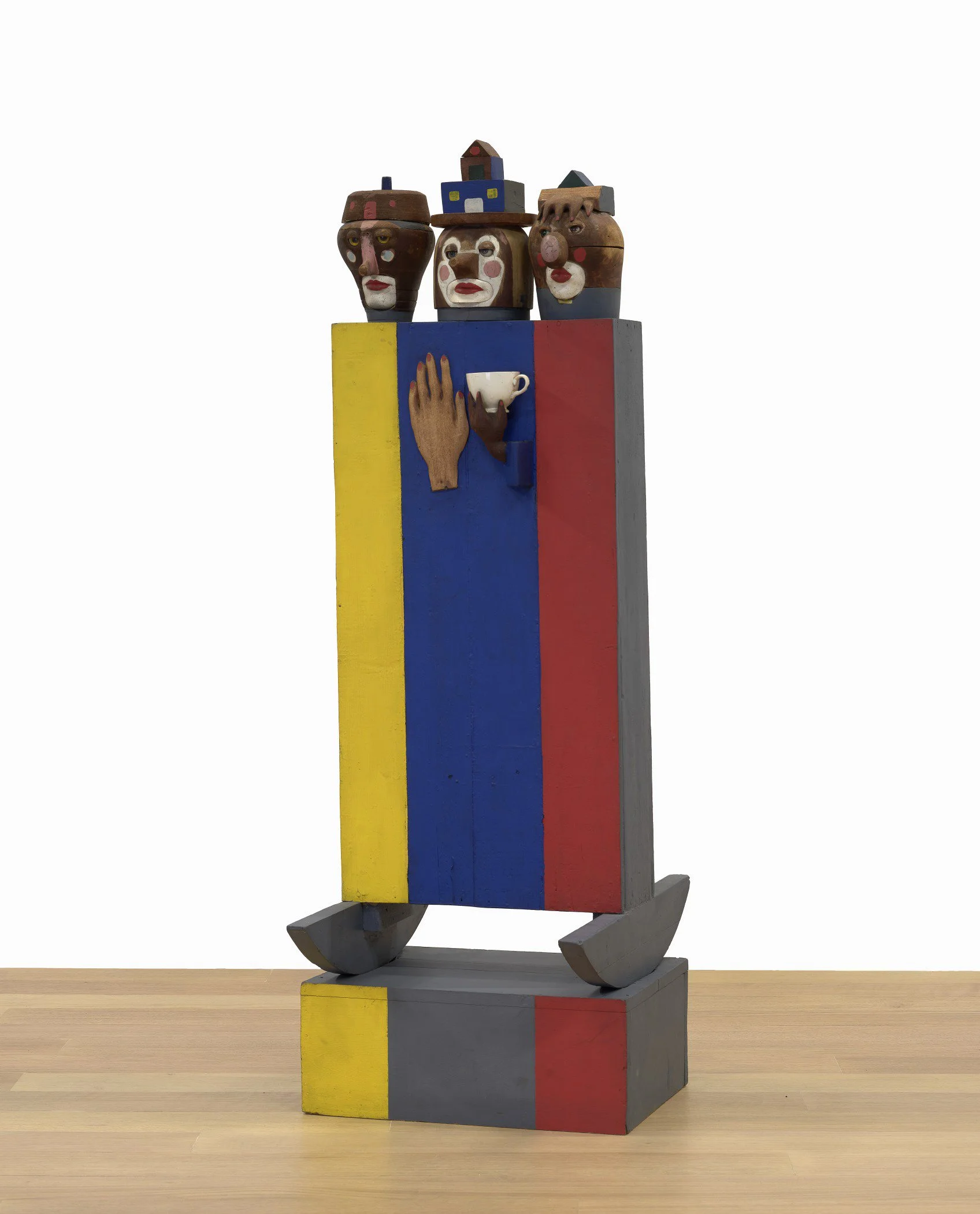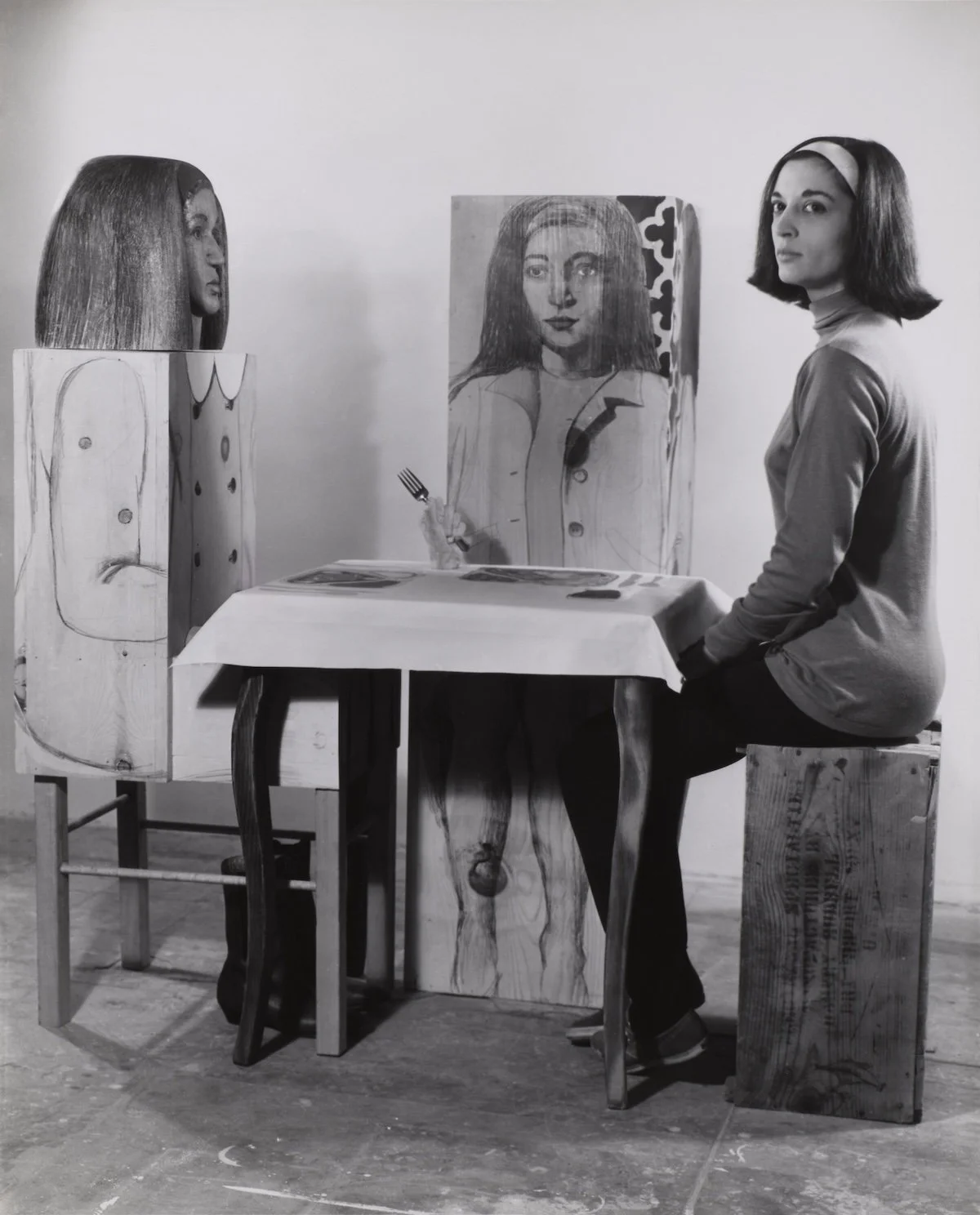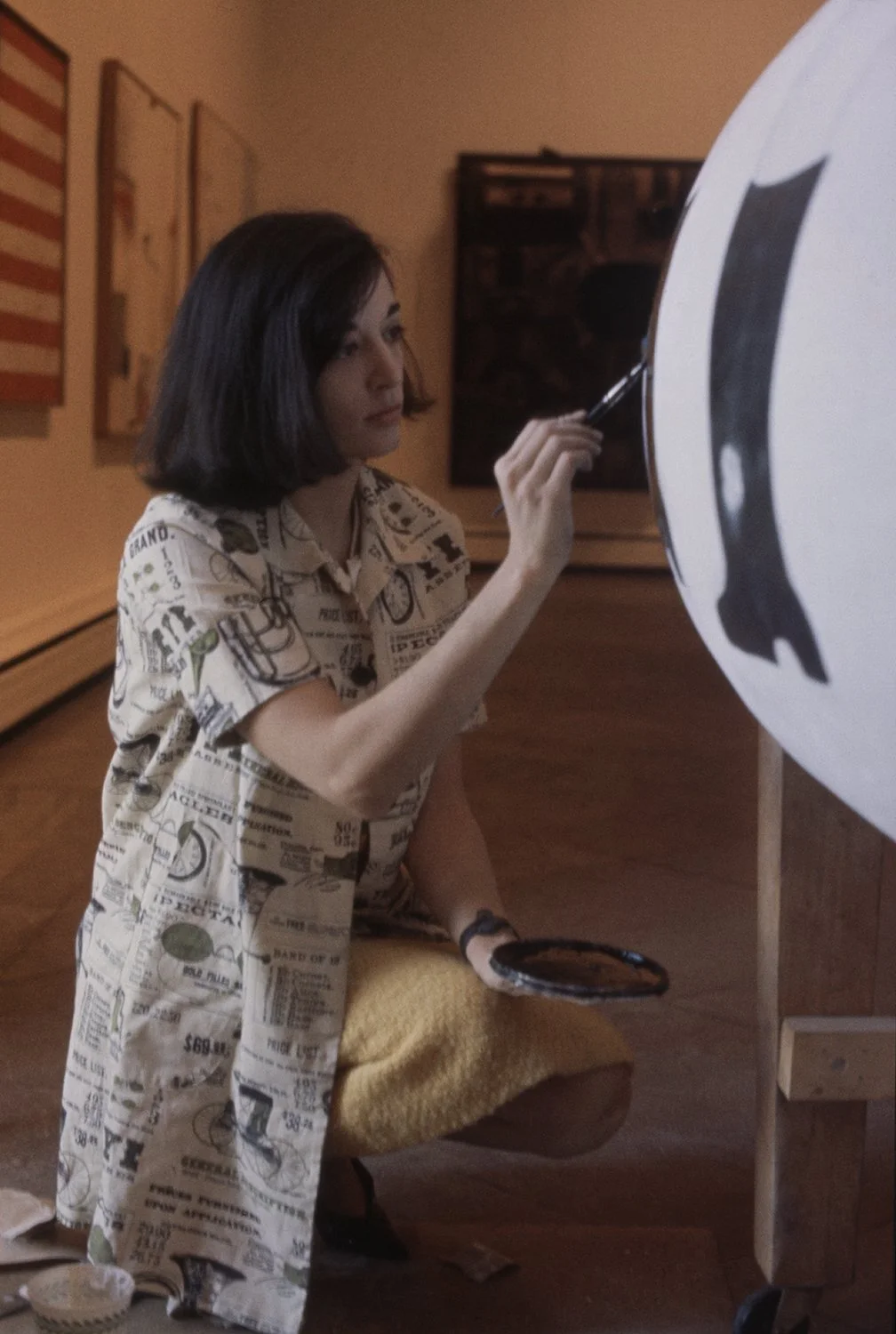A Tricolor Obscurity: On Marisol and Venezuela
“They say Marisol was very quiet, but when she had a drink or two, she loved to talk,” Venezuelan architect Carlos Brillembourg says, recalling his friendship with the artist. “She wasn’t quiet at all.” Just as the myth about her perpetual shyness came to falsely define her, so did her legacy as an artist. The Paris-born Marisol was more than a New York–based artist; Venezuela, her parents’ country, was crucial to the development of her craft.
Per the 2021–2022 Pittsburgh exhibition on Marisol and Andy Warhol’s friendship and the recent retrospective of her oeuvre at the Buffalo AKG Art Museum, the U.S. public has shown a renewed interest in the artist and her wooden sculptures. While institutions and art publications in the States discovering her work is a positive, the critical perspectives are insufficient. Readings of her work focus solely on her trajectory in New York—a city she called home for most of her life—rendering her Venezuelan identity irrelevant.
Take, for example, her spotlight on the National Gallery of Art’s website, which briefly mentions Venezuela as a country she represented at the 1968 Venice Biennale. Or Angelica Hankins’s perspective in the National Endowment for the Humanities, where she writes within dashes that the colors of the sculpture Tea for Three (1960) are a reference to the Venezuelan flag, sidelined as an unimportant detail.
When painter and critic Ara Ostwell wrote on Marisol for Artforum in 2024, the few post-pop art pieces she mentioned were Barracuda (1971) and The Fishman (1973), sculptures that reflected her passion for sea-diving and marine ecology. But Ostwell, also seemingly mischaracterizing her, states: “Marisol didn’t exactly vanish; she was disappeared. In the decades since artists like Marisol, Saint Phalle, and Yayoi Kusama were lauded as pioneers, the iconography of pop art has been universalized—which is to say sterilized, de-gendered, and whitewashed.” But is it appropriate to refer to her as a phantasm of sorts, as someone whose body and body of work faded from consciousness for several decades?
After her participation in the Venice Biennale in the late ‘60s, Marisol lived in Caracas on several occasions to work on various sculptures—mostly commissions from the Venezuelan government, including Monumento a Bolívar y Bello (1971), one of her most known artworks of this era.
Located in the central plaza of Instituto Venezolano de Investigaciones Científicas (IVIC), the 14-foot-tall sculpture depicts Venezuelan independence hero Simón Bolívar and his childhood teacher, the humanist Andrés Bello. Each with a book in hand, they stand under a tree. Surrounded by dogs, birds, and a lizard, these animals signal a connection between nature and history, between our primal selves and our cultural achievements.
Just as Marisol’s interest in marine biology intersected with her artistic pathos and her skills as a carpenter showcased her knowledge of engineering, the Monumento a Bolívar y Bello reflects the ties between fine arts and science that was essential to the mission of Venezuela’s modern state. Carlos Raúl Villanueva—who curated Marisol’s exhibition at the Venice Biennale—made this central to his renovation and extension of Universidad Central de Venezuela’s campus in the ‘60s, now a UNESCO World Heritage Site. Universidad Simón Bolívar, the country’s foremost public science university, is eerily similar to the floating city in Hayao Mityazaki’s Castle in the Sky (1986); although students there can only major in STEM, they must take general studies classes with a humanities bent and arts—no matter their program. The kinetic art atmospheres inside the turbine halls of Guri Dam—the hydroelectric plant that provides electricity to most of Venezuela—are memorable because they present the aesthetic alongside the technological.
Before Monumento a Bolívar y Bello, Marisol depicted Bolívar in The Generals (1962), which features him in front of George Washington, riding a barrel-bodied horse with legs from a chair and wheels instead of hooves. In contrast with the grandeur of her figures at IVIC, this wooden toylike sculpture inspires playfulness and childlike wonder, a recurring theme, potentially because Marisol lost her mother at a young age.
This representation of Bolívar and Washington might appear ridiculous, but it’s not ridiculing. The statue approaches the characters and their legacy from a more infantile perspective—how amused must Marisol have been at the thought of the two men riding one sole horse. This pop art piece follows the Warholian trend of celebrating and satirizing simultaneously.
Another noteworthy artwork is her statue José Gregorio Hernández (1974), named after the “doctor of the poor,” a figure Venezuelans of all social strata revere. This piece resides in the Andean town Isnotú and not in Caracas, where you can find most of her Venezuelan oeuvre. This is not by chance: Isnotú is the birthplace of the soon-to-be-saint and, as Brillembourg says, Marisol “always liked Venezuelan villages.”
This bronze statue, a site of pilgrimage for folks devoted to Hernández’s miracles, was especially important for the artist. Marisol once said, “I researched who he was and found the man interesting. A saint with a tie. He also reminded me a tad of my dad . . . I met many believers of José Gregorio, and I ended believing in him, too.” Unfortunately, the briefcase Marisol added to Hernández’s left and the dog she sculpted to his right were stolen, and today, weeds cover the square where the statue stands.
Although Marisol mentioned in 1965 that her art had no social intentions, that she thought about the forms and not the meaning, Brillembourg says she frequently defended the poor and the unfortunate: “Marisol had a strong social consciousness.” While there are no public registers of her changing her mind about what she expressed in the ‘60s, it seems to me like her sculptures progressively betrayed her words as she grew older.
If you trace a line between José Gregorio Hernández and one of her most iconic works from years later, The American Merchant Mariners’ Memorial (1991) in New York City, they both reflect her concern for underprivileged people. The American Merchant Mariners’ Memorial presents four men stranded at sea: one on his knees, apparently disillusioned; another with hands around his mouth, yelling out for help; one drowning, sometimes invisible to the spectator; and the last one reaching out to pull him back onto the abstract boat. The inspiration behind this piece was the sinking of the SS Muskogee—a ship that carried oil from Venezuela to the States—by the Germans during World War II. This memorial is a physical metaphor for Marisol’s hyphenated identity.
Other monuments by Marisol are present throughout Caracas. Still standing in Caño Amarillo is her 1983 tribute to Carlos Gardel, the Argentine singer who was immensely popular in Venezuela during his prime. So does her bronze monument to Isabella I of Castile, located in the main square of the wealthy neighborhood of La Castellana. Some only persist in memory, like her 1983 tribute to Rómulo Betancourt, the first president of Venezuela’s democratic era. This piece, a bronze medallion with the politician's face, a pipe clenched by his lips, was once in one of Caracas’s most frequented city parks, formerly known as Parque del Este Rómulo Betancourt. When Hugo Chávez’s administration changed its name to Parque Generalísimo Francisco de Miranda to honor an independence figure and sepult the legacies of past governments, it removed Marisol’s piece, which hasn’t been seen since.
Besides these commissions, many of Marisol’s pieces exist in private collections and within a handful of public museums. Los Mercaderes (1965) was one of the first acquisitions of Museo de Arte Contemporáneo de Caracas (MACC) and has been on view for 51 years. Many other pieces from the ‘60s up to the ‘90s are also in the museum’s possession, but most are in the institution’s storage, and according to Mimí Trujillo––a close friend of the artist and custodian of her assets––they are in deplorable condition. A good number of records, nonetheless, of her works at MACC–and in other galleries and institutions of Venezuela–are available on the University of Miami’s Sofía Ímber collection. Marisol’s various stays in Caracas were not mere trips but episodes that define the development of her craft after the ‘60s, that were also fundamental in the development of visual culture in her parents’ land—she won the National Prize for Fine Arts of Venezuela in 1984, after all. Her seminal works in Venezuela underscore her longstanding commitment to the country and the invaluable contributions to its cultural patrimony.
“Marisol loved caraqueño humor,” Brillembourg says. In other words, she was a fan of sarcasm and irony—the pillars of day-to-day interactions in Venezuela’s capital. She had Brillembourg build her a house in Pueblo de El Hatillo, a picturesque, colonial-style town in southeastern Caracas; nowadays, the space hosts a gallery called sietealcubo and Trattoria Tata, a family restaurant. Not only was Marisol connected to Venezuela through her familial background but also in aspects of her personality and in material, physical spaces as well.
Despite this, art critic Jennifer Josten affirms in the essay she wrote for the 2022 book Marisol and Warhol Take New York that—per a 1968 interview with Barbara Gold—Marisol didn’t think of herself as Venezuelan. She told Gold, “I don’t like to go by countries. I don’t like nationalism. I like to be able to go anywhere as an independent person. I hate the idea of countries anyway.” But as her enthusiasm for pop art waned and she dedicated more of her attention and energy to the northernmost South American country, her relationship with Venezuela changed. Venezuelan artist Rolando Peña, who crossed paths with Marisol in New York, and Brillembourg both agree she wasn’t a nationalist. But is obsessing passionately, publicly about one’s nation a necessary condition to claim belonging to such a place?
“I wouldn’t encapsulate Marisol as a Venezuelan artist; I think her work was more universal than anything,” Peña says. Brillembourg agrees. Perhaps this is partially because of Marisol’s taste and practices; she was, after all, particularly fond of Michelangelo and Da Vinci. However, there is no contradiction between the universality of Marisol’s works and her place in the canon of Venezuela’s fine arts—especially when, in contrast with artists whose kinetic sculptures have become synonymous with visual arts for myriad Venezuelans, she dared sculpt figurative representations of various national icons.
Besides Estrellita Brodsky’s essay in the Buffalo AKG retrospective catalog, the absence of focus on her Venezuela pieces in the United States is striking. Insisting that Marisol lost her momentum and faded into the background after pop art stopped being trendy casts a shadow over the developments of fine arts outside the United States— that is, to promote erasure. We must be careful with upholding a discourse that qualifies the development and appreciation of fine arts in Latin America as secondary—perhaps, not even relevant. If Marisol retreated into obscurity, it was yellow, blue, and red.





